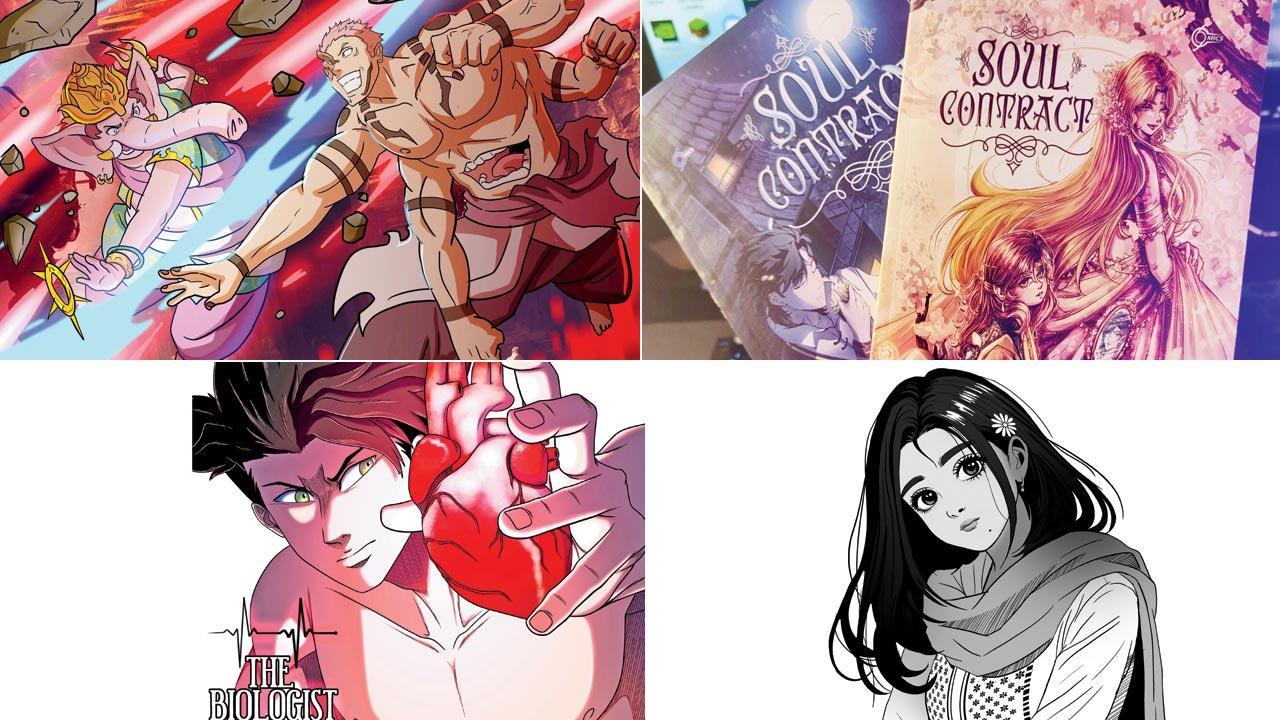The Indian government is giving a platform to anime and manga artists, aiming to bring them out of the niche. How many will be discovered?

Artwork by Aparna Chaurasia, Puneet Varshney, Sumandeep Singh, Jazyl Homavazir
When we think manga, we think Japan, but pop culture often travels far and wide. In Mumbai, Byculla resident Jazyl Homavazir is India’s first award-winning manga artist. For decades, he has been drawing characters inspired by Indian mythology in manga art styles. His work, The Beast Legion, was the first web manga to crop up from India, and years later, it still pulls in readers. His latest is a trailer for The Vrindavan Chronicles, where Lord Krishna is the protagonist. And, at the time of publishing, it has crossed over 127K views on Instagram in less than a week.
ADVERTISEMENT
Homavazir and his ilk may be the reason for an ongoing contest across the country. Waves Anime & Manga Contest (WAM) is aiming at offering a platform to Indian manga artists. The championship, which is a joint initiative of the Indian Comics Association (ICA) and the World Audio Visual & Entertainment Summit, held by the Ministry of Information and Broadcasting (MIB), Government of India, is part of the “Create in India Challenge”, a programme of the government to promote Indian creativity and innovation globally.
 Jayshankar J
Jayshankar J
The manga and anime fandom is not new. For a generation that grew up watching anime on Doordarshan in 1993, it was part of their childhood. India now has the second-largest number of anime and manga fans after China. As per a JetSyntesys 2022 report, 84 per cent of Indian fans are investing in manga and anime merchandise as well.
So naturally, Homavazir is not the only manga artist in the country any more. Aparna Chaurasia, who creates out of Chhatarpur, Madhya Pradesh, has published her manga, Soul Contract with Cosmics, one of India’s few manga publishers. Like Homavazir, Chaurasia too blends Indian cultural aesthetics with Japanese manga styles. Her manga is a dark fantasy centred around reincarnation. “I had watched Sanjay Leela Bhansali’s Gangubai and Heeramandi at the time and felt inspired. So, my protagonist grows up in a red-light area and is not allowed to go to school as she’s a young girl. Her mother dresses her up as a boy and sends her to the gurukul,” says Chaurasia.
 Aparna Chaurasia, Jayshankar, Jazyl Homavazir and Sumandeep Singh
Aparna Chaurasia, Jayshankar, Jazyl Homavazir and Sumandeep Singh
Contrary to Homavazir and Chaurasia, a manga artist from Bengaluru, Jayshankar J grew up in Kerala reading manga and enjoyed it from a different lens. “There are stories that are an artist’s interpretation of other cultures, like a World War setting. For example, Berserk is a dark fantasy and is set in medieval Europe,” he says. It’s what Jayshankar does with his storytelling as well, as he believes that interpreting a culture that’s not his own leaves him more room for storytelling. He’s currently working on his manga Road to Alexandria, based on the burnt-down Library of Alexandria in Egypt, in which an old man and a young boy take a journey together.
But what makes manga different from traditional comics? “I think the most important thing is dynamics and panelling. To the untrained eye, it all looks similar. However the placement of dialogue boxes, the action sequences, and how those two correlate differs. Traditional comics keep everything organised, while manga breaks out of these boxes or panels and that also transforms with the story,” says Jayshankar.
 Puneet Varshney, artist
Puneet Varshney, artist
Another key feature of manga is that the comics are read from right to left, as the traditional Japanese writing system, Tategaki, is written vertically with columns ordered from right to left, and manga panels and speech bubbles follow this convention. So each book begins from what you would call the back.
While designing his first-ever manga project professionally, Kolkata-based Sumandeep Singh dove head-first into research. Traditionally, manga was printed in black and white to keep costs down, and used recycled paper, he says.
But manga is believed to be much older. Around 1200 AD, an anonymous artist painted humorous handscrolls showing rabbits and monkeys bathing in a river, frogs and rabbits wrestling, and other scenes of animals behaving like humans. These are known as the Handscrolls of Frolicking Animals or Chōjū giga, considered by some to be the first manga. Later, The Tale of the Monkeys from the late 1500s which showcased monkeys in human situations had speech bubbles and other techniques that are now essential to modern manga.
Over the years, as manga artists have grown, so have the art styles, but some techniques remain. Now, Indian manga artists are localising content. “It’s because only Japanese stories and characters will not help manga grow in India. The lifestyle, clothes, and characters need to be represented in the Indian context. While the more popular stories revolve around Indian mythology, you have to be careful to not hurt sentiments. But gradually, we are seeing themes of national pride, young Indian love stories, and school settings trickle into Indian manga,” says Puneet Varshney, an artist from Faridabad.
Finding these Indian manga artists and honing their talent is why contests like WAM are also receiving government support. Homavazir, who is on the jury panel for the contest, says, “Indian manga artists are creating artwork because it’s outsourced to India. Very few are into local content. There are no big publishers supporting manga and no platform to distribute it. If there was a platform, properly advertised, it would make a huge difference.” Chaurasia, who was approached by Cosmics to create her manga, adds, “Such competitions will also encourage more artists, and will help parents understand that this can be a serious career.”
1200 AD
When the Handscrolls of Frolicking Animals or Choju giga, believed to be the first incarnation of manga, were painted
 Subscribe today by clicking the link and stay updated with the latest news!" Click here!
Subscribe today by clicking the link and stay updated with the latest news!" Click here!







